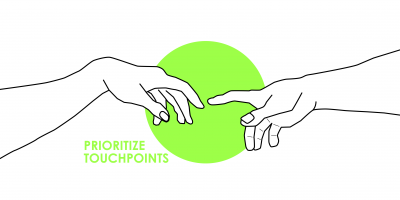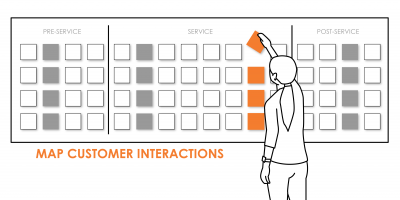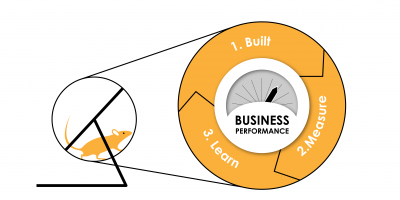By: Damien Nunes / Dominik Mahr / Tom Klaassen
The central role of Interaction Design when creating delightful customer experiences
Organisations depend on their competitive advantage in order to become or keep successful, relevant for their customers and grow over time. As we all know, competitive advantage is achieved via either one – or a combination – of the strategies involving pricing, service and product quality or customer service excellence. We argue that another overarching strategy should always be present in a company’s strategy; delivering an excellent, desirable and memorable customer experience.
The customer experience depends not only on the purchase transaction and the actual use of the product or service, but on the entire customer journey with multiple customer-organisation interactions in various stages; from first encounter with the brand to after sales and second time use. Customer Experience Management is therefore a top priority for management in order to keep customers satisfied, loyal and create ambassadorship.
It is a topic that is very much alive, but for many organizations still difficult to start with, let alone succeed in. Companies need to think about all touchpoints and interactions that customers have with their organization; planned and unplanned, direct and indirect, long before a purchase and after the customer has been serviced, and so on, and then formulate a strategy to influence and optimize these touchpoints. Where to begin? With a ‘holistic overview’! After all, all these interactions combined influence the relationship and the decision for or against a purchase and the customer’s attitude towards the brand.
In order to truly understand their customers, organisations need to master the skills and knowledge of Interaction Design (IxD). IxD is a fascinating combination of an empathic (“soft”) skillset rooted in psychology, cognitive science, behavioural science, and design, combined with a quantitative (“hard”) skillset with a background in data analytics, information systems, and technology.
During this article we will we zoom into success factors for implementing IxD in organizations; our “Key management questions” give managers reflection and guidance with regard to implementation.

What is Interaction Design?
Traditionally, Interaction Design focused on creating and improving interactions between customers and products or services in order to make the use of the product or service valuable and meaningful. The interaction involves elements like aesthetics, motion, sound, space, smell, and many more.
Given the importance of customer interaction for future business success, the role of Interaction Design is moving from a design expertise niche to a tactical and strategic must-have discipline for management.
This strategic importance also stems from customers’ expectations for a “seamless omni-channel experience”; neatly connected interactions across and within both digital and non-digital channels. Delivering this is difficult, especially when several parties are involved in the experience, as is often the case. For example, think about the online purchase of a chair that involves the shopping website, the chair manufacturer, other customers (through reviews), and the postal service.
Interaction design is the mortar to connect the various building blocks of the experience. It starts with understanding the motivations, emotions, and behaviour of customers, the opportunities of technology devices, and the priorities of business strategy. This understanding is then translated into actionable design criteria for a particular service and its interfaces.

Creating an Organization-wide Customer Interaction Model
To obtain a holistic overview of the strategic and operational aspects of the organizational value proposition, we can combine tools such as a multi-level customer experience map with the service blueprint to map out the complexity of the service system.
The customer experience map graphically represents how the customer interacts with your organization, via which touchpoints and how this journey is perceived. The service blueprint complements this perspective by showing which employees and systems from various departments need to work together in order to realize the desired service experience. The combination of these tools has proven to be a powerful way to align departments by creating a common language and focus, understand where the customer journey can be further optimized and to deliver a seamless and resonating service experience over which the organization is in control.
These tools are dynamic and used iteratively for continuous improvement of the customer experience and value delivered.

Key management questions:
Do we have a multi-level experience map of our service that maps the customer interactions across our organization?
Is this map used to align departments and does it provide a basis for reflection for tactic and strategic purposes?
Do we regularly update the organization-customer interaction model together with our customers?
Do we systematically translate the customer insights from these updates into delighting customer experiences?
Digitalization of Services and New Ways of Interacting with Customers
The digitalization of services and products opens up many new ways to interact directly with individual customers on a far larger and more personal scale. Where television used to be the dominant medium to reach customers by pushing one message to a large audience, we now see that the smartphone is a new interactive gateway that revolutionized the game rules with regard to customer engagement. We can deliver various engaging pieces of content and most importantly, offer the opportunity to engage in a dialogue with customers at any moment in time.
Obviously, technology is not stopping here. We see systems steadily becoming smarter and communicating in a more human-like way. Google for instance showed during its I/O-conference how its virtual assistant is able to make a restaurant reservation via a telephone call in the background while the user is organizing a get together with friends. This is a good example where Natural Language Processing, Smart Algorithms and Machine Learning mechanisms come together in order to deliver a smart service that creates new interaction opportunities.

And it is not just about smart background processes. New technologies and interfaces are taking a big leap themselves. For instance, Virtual Reality and Augmented Reality open up new ways to interact with technology and deliver services. With the exponential growth of computing power, and the improvement of devices it won’t take long before we will enter a new virtual interaction era.
The Internet-of-Things is driving change by adding ‘smart’ capabilities to ‘dumb’ products through incorporating computing power and connecting them via the internet. We already see the transformation of our televisions into smart TV’s, smart lights such as Philips hue, and the first robots are entering our homes in the form of autonomous vacuum cleaners. These applications will probably only grow in number and capabilities in the near future as technology is advancing. At the same time, privacy and data protection issues are increasingly an integral part of the design.
Key management questions:
Are we aware of the technology out there and how it can benefit our customer interaction?
Do we experiment with the application of new technology and customer interfaces?
User insights as the main source for business decision making
In order to drive business decisions, managing customer experiences and interactions is crucial which makes it even more important to gather user insights in a structural way. Based on the company’s business goals, we should define a set of KPIs in order to understand which factors influence achieving the predefined business goals. By structurally measuring metrics that are directly impacting the KPIs, a company can determine how changes in interactions and touchpoints influence the performance of a service, product or the company as a whole.

Qualitative data such as data from online and offline interviews, usability studies, focus groups, observational studies, mystery shopping and research diaries, uncovers the underlying reasons why the service is performing in a certain way and why customers engage or disengage at certain touchpoints.
Combining both quantitative and qualitative data gives a company the power to understand how its own employees and the customer’s behaviour is affecting the performance of the service. With this knowledge, companies can start learning what business decisions have a positive impact and quickly act in case an intervention has a negative impact on the service performance.
Key management questions:
Do we measure the customer perception and behaviour per interaction point?
Do we conduct research that aims to uncover the unknown and challenge our organizational perspective?
Never stop learning and improving, it’s an iterative process
Customers rarely interact with our services exactly as we initially designed them on the drawing board. Therefore, organizational learning and incremental innovation should not only be part of the designing stages of the service, but should also be incorporated in the implementation and operationalization of the service. Only then your organization is able to reach service excellence and truly delight its customers in an unprecedented way.
This gives a total new dimension to interaction design: interaction becomes a necessary service- component for acquiring customer feedback and translating this into actual value and an improved (or new) service experience. This is also helpful to realize the ambition to forge a customer relationship that will grow stronger over time, creating a competitive advantage by creating customer loyalty and thereby lowering the investment in customer acquisition. Customers should therefore be made aware that their (in)direct interaction with the organization results in direct benefits for themselves: in the form of better, faster and more personalized offerings.

In practice, this means that you have to be sensitive in how you apply the build, measure, learn- cycle in your customer-organization interaction map. You don’t want to overburden your customers but on the other hand, you need the necessary insights in order to improve your offerings.
Furthermore employees need to take insights with regard to the performance of the service seriously and pro-actively conduct additional research in order to have a complete overview of the performance, bottlenecks and opportunities of the service.
Interaction design can help to define the boundaries of a common ground where interaction is mutually beneficial and sustainable for both customers and organization.
Key management questions:
Do we innovate in linear projects or circular processes?
Do we incorporate both the incremental and radical innovation of services?
Do we incentivize our employees to fail fast and fail forward?
A final note before getting started…
Even though our world is becoming more digital and technology driven, we see that the need for a human touch is also growing. Technology can help to make your organization more empathic but your employees also need to understand the importance of being customer-centric; understanding your customer’s behaviour, needs and wishes is crucial to understand how your organization should operate and act. This involves changing the mind-set and also acquiring design and research competences to actually practice incremental and radical innovation that matters to your customers. We hope this article incentivized you to dive deeper in to the world of interaction design!
IxD helps organizations to be human-centered… it is about who the organization is, what it does and why it exists…
About the Authors
Dr. Dominik Mahr | Associate professor for Service Innovation
Dominik is Associate Professor at Maastricht University and Scientific Director of the Service Science Factory (part of Maastricht University). He is an Academic Expert in ‘Innovation & Service Design’ within UMIO, which provides educational trajectories for professionals and business services in the form of Service Innovation Projects and educations. All these offerings have a scientific foundation based on academic expertise and relevant research.
E-mail: d.mahr@maastrichtuniversity.nl
Damien Luciën Nunes | Service Designer & Innovation Coach/Trainer
Damien currently is active as a content expert within Service Innovation projects and as a Service Design practitioner at UMIO’s Service Science Factory. Besides participating in and managing projects, Damien also inspires, trains and coaches students and professionals on the mind-set, process and skills needed to develop and improve services.
E-mail: d.nunes@maastrichtuniversity.nl
Tom Klaassen | UX-Designer and owner of UX agency Bankai
Tom combines 10 + years of experience in designing high-end digital products with masters in Communication Design and Marketing Management. He quickly acclimatizes with different business challenges and specializes in converting end-user insights to innovative and successful digital solutions with Bankai.
E-mail: tom@bankai.eu
Featured image via Unsplash.

